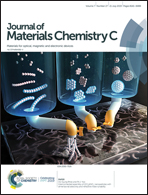High sensitivity and wide sensing range of stretchable sensors with conductive microsphere array structures†
Abstract
In the past decade, stretchable strain sensors have received widespread attention due to their enormous application potential, but it is still a challenge to obtain sensing materials with both high sensitivity and a wide operating range. To this end, we designed a binary structure composed of a polystyrene/graphene conductive microsphere array and graphene nanosheets mingled freely with the microsphere array. Based on this structure, it was found that the properties of the material can be effectively adjusted by controlling the particle size of the polystyrene microspheres and the graphene content. As expected, the bridging effect of this unique binary structure allows the sensor to exhibit high sensitivity (gauge factor = 481), a wide sensing range (maximum sensing strain = 104.5%) and good linearity (R2 ≥ 95%). And the structure has good stability, even after 3000 cycles there is no significant change in the sensing performance. In addition, by introducing one-dimensional oxidized carbon nanotubes and silver nanowires into the sensor to further enhance the bridging effect, the sensitivity and operating range of the sensor are improved again (gauge factor = 1171, maximum sensing strain = 134.4%). The sensor can be used for practical applications such as human motion detection and object mass detection.



 Please wait while we load your content...
Please wait while we load your content...